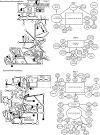Phylogeography of two moray eels indicates high dispersal throughout the indo-pacific
- PMID: 20375076
- PMCID: PMC2884193
- DOI: 10.1093/jhered/esq036
Phylogeography of two moray eels indicates high dispersal throughout the indo-pacific
Abstract
Reef fishes disperse primarily as oceanic "pelagic" larvae, and debate continues over the extent of this dispersal, with recent evidence for geographically restricted (closed) populations in some species. In contrast, moray eels have the longest pelagic larval stages among reef fishes, possibly providing opportunities to disperse over great distances. We test this prediction by measuring mitochondrial DNA (mtDNA) and nuclear DNA variation in 2 species of moray eels, Gymnothorax undulatus (N = 165) and G. flavimarginatus (N = 124), sampled at 14-15 locations across the Indo-Pacific. The mtDNA data comprise 632 bp of cytochrome b and 596 bp of cytochrome oxidase I. Nuclear markers include 2 recombination-activating loci (421 bp of RAG-1 and 754 bp of RAG-2). Analyses of molecular variance and Mantel tests indicate little or no genetic differentiation, and no isolation by distance, across 22 000 km of the Indo-Pacific. We estimate that mitochondrial genetic variation coalesces within the past about 2.3 million years (My) for G. flavimarginatus and within the past about 5.9 My for G. undulatus. Permutation tests of geographic distance on the mitochondrial haplotype networks indicate recent range expansions for some younger haplotypes (estimated within approximately 600 000 years) and episodic fragmentation of populations at times of low sea level. Our results support the predictions that the extended larval durations of moray eels enable ocean-wide genetic continuity of populations. This is the first phylogeographic survey of the moray eels, and morays are the first reef fishes known to be genetically homogeneous across the entire Indo-Pacific.
Figures



Similar articles
-
Molecular phylogenetics of moray eels (Muraenidae) demonstrates multiple origins of a shell-crushing jaw (Gymnomuraena, Echidna) and multiple colonizations of the Atlantic Ocean.Mol Phylogenet Evol. 2010 Nov;57(2):829-35. doi: 10.1016/j.ympev.2010.07.013. Epub 2010 Jul 30. Mol Phylogenet Evol. 2010. PMID: 20674752
-
Pleistocene isolation and recent gene flow in Haliotis asinina, an Indo-Pacific vetigastropod with limited dispersal capacity.Mol Ecol. 2007 Jan;16(2):289-304. doi: 10.1111/j.1365-294X.2006.03141.x. Mol Ecol. 2007. PMID: 17217345
-
Worldwide phylogeography of the blacktip shark (Carcharhinus limbatus) inferred from mitochondrial DNA reveals isolation of western Atlantic populations coupled with recent Pacific dispersal.Mol Ecol. 2006 Oct;15(12):3669-79. doi: 10.1111/j.1365-294X.2006.03036.x. Mol Ecol. 2006. PMID: 17032265
-
Phylogeography of the pantropical sea urchin Tripneustes: contrasting patterns of population structure between oceans.Evolution. 2003 Sep;57(9):2026-36. doi: 10.1111/j.0014-3820.2003.tb00382.x. Evolution. 2003. PMID: 14575324
-
Range-Wide Population Structure of 3 Deepwater Eteline Snappers Across the Indo-Pacific Basin.J Hered. 2020 Sep 30;111(5):471-485. doi: 10.1093/jhered/esaa029. J Hered. 2020. PMID: 32803261
Cited by
-
The influence of Pleistocene climatic changes and ocean currents on the phylogeography of the southern African barnacle, Tetraclita serrata (Thoracica; Cirripedia).PLoS One. 2014 Jul 23;9(7):e102115. doi: 10.1371/journal.pone.0102115. eCollection 2014. PLoS One. 2014. PMID: 25054971 Free PMC article.
-
Is the Great Barracuda (Sphyraena barracuda) a reef fish or a pelagic fish? The phylogeographic perspective.Mar Biol. 2012 May 1;159(5):975-985. doi: 10.1007/s00227-012-1878-9. Mar Biol. 2012. PMID: 25594680 Free PMC article.
-
Linking ciguatera poisoning to spatial ecology of fish: a novel approach to examining the distribution of biotoxin levels in the great barracuda by combining non-lethal blood sampling and biotelemetry.Sci Total Environ. 2012 Jun 15;427-428:98-105. doi: 10.1016/j.scitotenv.2011.11.053. Epub 2012 May 3. Sci Total Environ. 2012. PMID: 22560748
-
Contrasting population genetic structure in three aggregating groupers (Percoidei: Epinephelidae) in the Indo-West Pacific: the importance of reproductive mode.BMC Evol Biol. 2018 Dec 4;18(1):180. doi: 10.1186/s12862-018-1284-0. BMC Evol Biol. 2018. PMID: 30514203 Free PMC article.
-
Mitochondrial ATPase 6/8 genes reveal genetic divergence in the Coilia dussumieri (Valenciennes, 1848) populations of north east and northwest coasts of India.Mol Biol Rep. 2014 Jun;41(6):3723-31. doi: 10.1007/s11033-014-3237-z. Epub 2014 Apr 9. Mol Biol Rep. 2014. PMID: 24715608
References
-
- Atema J, Kingsford MJ, Gerlack G. Larval reef fish could use odour for detection, retention and orientation to reefs. Mar Ecol Prog Ser. 2002;241:151–160.
-
- Barber PH, Erdmann MV, Palumbi SR. Comparative phylogeography of three codistributed stomatopods: origins and timing of regional lineage diversification in the coral triangle. Evolution. 2006;60:1825–1839. - PubMed
-
- Bay LK, Choat HJ, Van Herwerden L, Robertson DR. High genetic diversities and complex genetic structure in an Indo-Pacific tropical reef fish (Chlorurus sordidus): evidence of an unstable evolutionary past? Mar Biol. 2004;144:757–767.
-
- Benjamini Y, Hochberg Y. Controlling the false discovery rate: a practical and powerful approach to multiple testing. J R Stat Soc Proc B. 1995;57:289–300.
-
- Bermingham E, McCafferty SS, Martin AP. Fish biogeography and molecular clocks: perspectives from the Panamanian isthmus. In: Kocher TD, Stepien CA, editors. Molecular systematics of fishes. New York: Academic Press; 1997. pp. 113–128.
Publication types
MeSH terms
Substances
LinkOut - more resources
Full Text Sources
Research Materials
Miscellaneous

